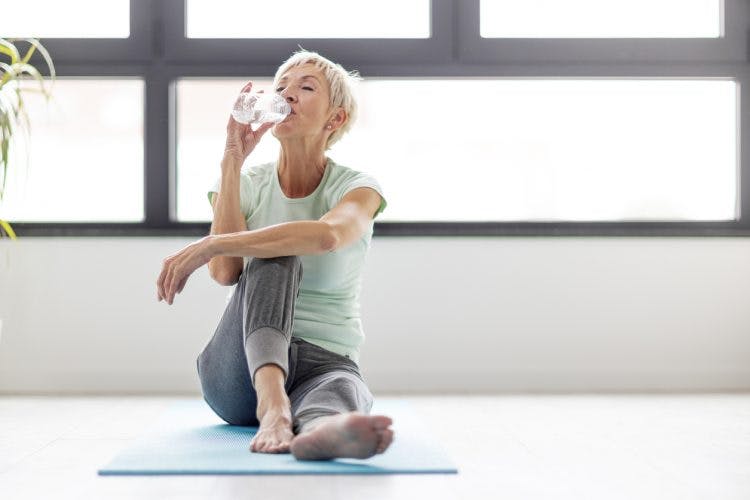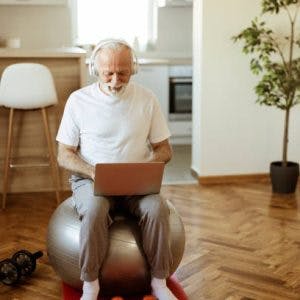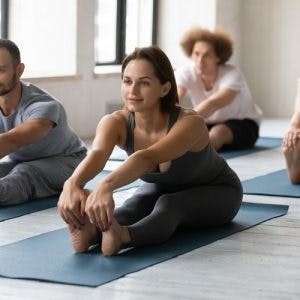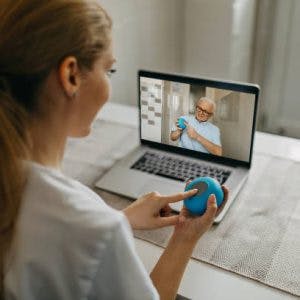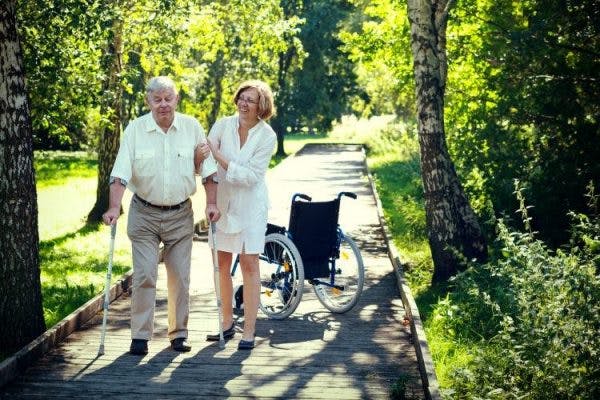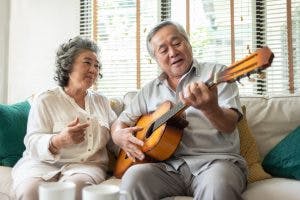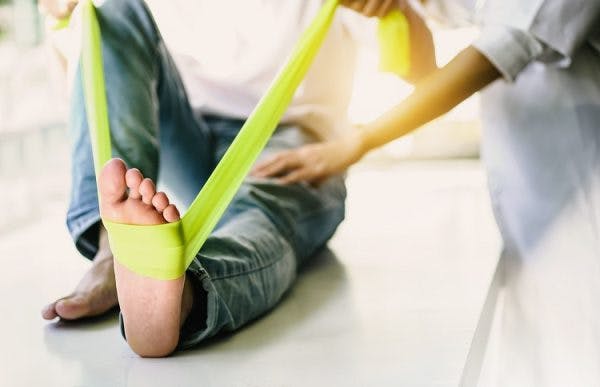Stroke exercises are an important tool for survivors that want to improve mobility. Research shows that there is a critical time period up to 6-8 months after a stroke when the most recovery occurs with rehabilitation. However, there is also evidence that neuroplasticity continues throughout the lifespan. In fact, a consistent home exercise program is one of the best ways to continue recovery well beyond discharge from inpatient rehabilitation.
This post contains examples of full-body stroke exercises that you can practice at home. Each section contains a video featuring a licensed therapist so that you can follow along. Whether you want to recover from paralysis, improve strength or mobility, or sharpen your fine motor skills, this article has something for everyone.
Jump straight to any stroke exercise section by using the links below:
- Adjusting to your ability level
- Leg exercises
- Balance and core exercises
- Arm exercises
- Shoulder and upper extremity exercises
- Wrist, hand, and finger exercises
- Paralysis recovery exercises
- How many repetitions is ideal?
How to Adjust Stroke Exercises to Your Ability Level
Before we get started, it’s important to know how to adjust your stroke exercises to suit your ability level because survivors with paralysis need different techniques than survivors with existing strength or movement. With all of these stroke exercises, it’s important that they are challenging enough but not so easy that it doesn’t stimulate more neuroplasticity.
If you are starting with no movement on your affected side, you can encourage recovery by starting with passive exercise, which means assisting your affected side through the movement. This can be achieved by either using your non-affected side or by enlisting the help of a caregiver or therapist.
Passive exercise uses assistance to move your body if it does not have full strength, and helps patients recover from paralysis by stimulating neuroplasticity. This is the mechanism the brain uses to rewire and heal itself after injury. It’s the key to recovery and learning new skills.
Stroke survivors that have partial movement, and wish to improve more, can continue with active exercise. This means doing the movement on your own without help.
Whether you are starting with no movement or partial movement, neuroplasticity is always the goal. You can encourage neuroplasticity by performing high repetition of your stroke exercises with conscious attention and your goals in mind.
Repetition is how the brain perceives the need for a function, and it rewires itself accordingly. Think: the more you use it, the more you improve it. You will see faster results if you practice every day instead of once per week.
Furthermore, paying attention to the quality of the movement and why you are doing the stroke exercise will stimulate neuroplasticity even more. With that said, let’s dig into the full-body stroke exercises. We will work from the bottom up, starting with the legs.
Stroke Recovery Exercises for Legs
Follow along to these leg exercises with Liliana, DPT, in our YouTube video above.
Stroke exercises for the legs can help survivors improve their strength, gait (manner of walking), and balance. Training the legs can also help reduce the risk of falling, which is a priority for all stroke survivors.
Knee Extensions
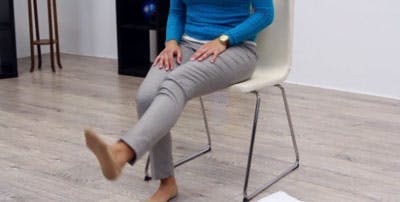
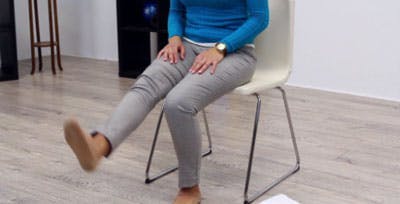
For this leg exercise, start in a seated position while maintaining good postural alignment. Then, extend your leg to straighten the knee while contracting your thigh (quadriceps) muscles. Hold for 3 seconds, then slowly bring your foot back down to the floor.
Repeat with your right leg, alternating back and forth between legs for a total of 20 repetitions (10 on each leg). Try to keep your posture throughout the movement.
Seated Marching
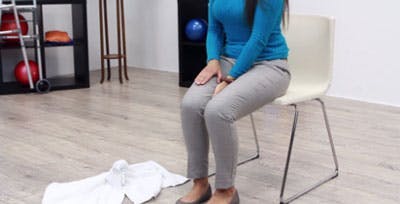
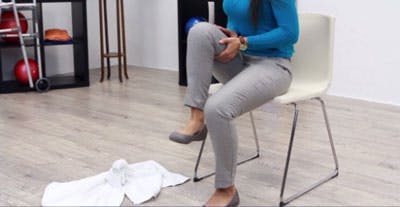
This stroke recovery exercise is good for increasing your hip flexor strength, which is important for picking up our feet when walking and for stairs. Stay in a seated position, and then lift your knee up towards your chest.
Then place your foot back down onto the floor. Repeat on the other leg, alternating back and forth for a total of 20 repetitions. Again, be mindful of your posture by engaging your abdominals and avoid leaning or slumping when moving your legs.
Ankle Dorsiflexion Exercise
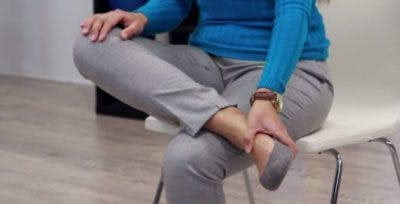
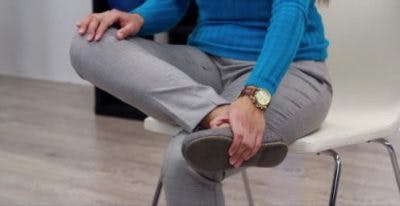
Stroke patients that have ankle stiffness or struggle with foot drop (difficulty with dorsiflexion) will greatly benefit from this particular stroke exercise. Start with your affected leg crossed over your other leg.
Then, flex your foot back towards your shin – a movement known as dorsiflexion. Slowly pump your ankles up and down for a total of 15 to 20 repetitions, then switch sides. If you cannot do this, use your hand to assist your foot through the movement, thus making it a passive exercise.
See all leg exercises for stroke patients »
Want 25 pages of stroke recovery exercises in a PDF? Click here to download our free Stroke Rehab Exercise ebook now (link opens a pop up for uninterrupted reading)
Stroke Exercises for Balance and Core
In our YouTube video above, physical therapist Cassie demonstrates stroke rehab exercises that target the trunk for improved balance. These stroke exercises help improve core stability and gait, while reducing the risk of falling.
Trunk Rotation (Twists)
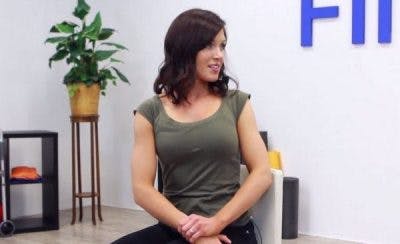
This particular stroke exercise is helpful for all impairment levels. Start from a seated position with your back straight and chest up. Place your right hand on the outside of your left thigh. Then, use your arm to gently twist your torso to the left.
Think about initiating the movement from your core, not your arms. Also, don’t twist to the point of pain. Move gently. Return to center and complete this trunk rotation 15 times. To increase the challenge of this exercise, try performing the trunk rotations with your arms crossed over your chest so that you’re using only your core muscles for the movement.
The next two stroke exercises require some core strength. If your lower back starts to lift up off the floor, skip these movements until you’re ready.
Knee to Chest
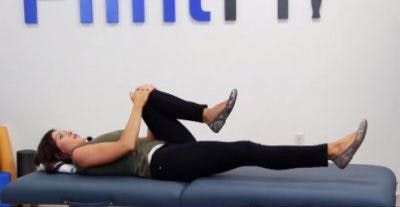
This stroke exercise is called the knee-to-chest. Start from a comfortable lying position, and then bring your right knee towards your chest. At the top, lightly squeeze in your abdominals, then bring your leg back down. You may also feel a stretch in your hip and glutes. Try your best to initiate the movement from your core instead of your leg. Repeat on each leg a total of 10 repetitions.
Toe Tap Core Exercise
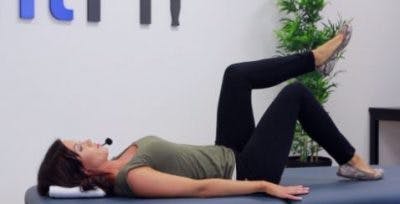
Lie down on your back and bend your hip and knees at a 90-degree angle. Flatten your lower back against the mat or ground by lightly drawing in your abdominals to maintain a neutral spine. Make sure you’re still able to breathe! From there, slowly lower your left leg down to tap your foot and bring it back up using your core muscles. Alternate sides for a total of 20 repetitions.
Maintain a 90-degree bend in your knee the entire time and focus on initiating the movement from your core not your legs. If you are having trouble keeping your lower back from lifting off the floor. Try doing the march starting with both feet down instead of elevated.
See all trunk/core exercises for stroke patients »
Stroke Rehab Exercises for Arms
Watch Barbara, OTA, demonstrate these stroke exercises for the arm in our YouTube video above.
Arm exercises are particularly helpful for getting back to the activities of daily living, like getting dressed and using the toilet. Be sure to work these stroke recovery exercises into your daily regimen.
Tabletop Circle Exercise


Lace your fingers together and wrap both hands around a water bottle. By engaging both sides of the body, this exercise becomes a bilateral movement, which is helpful during stroke recovery because it stimulates both sides of the brain. It also allows you to use your unaffected side to help the other with the movement.
With your fingers laced around the bottle, begin to make large circular movements. You can use your non-affected arm to guide your affected arm through this exercise. Make 10 slow, controlled circles. Try going both clockwise and counterclockwise.
Unweighted Bicep Curls


This stroke recovery exercise is important for regaining the ability to bend your arm and perform tasks like feeding yourself. Start with your elbow on a table with your arm bent at 90-degrees. Then, curl your hand towards your shoulder, then lower it back down to the table. Slowly repeat 10 times, focusing on isolating the movement at just the elbow.
The upward motion activates your biceps, and the downward motion activates your triceps. Because this recovery exercise is unweighted, it’s not intended to build strength. Rather, it’s intended to develop motor control and to stimulate neuroplasticity in the brain.
Open Arm Exercise
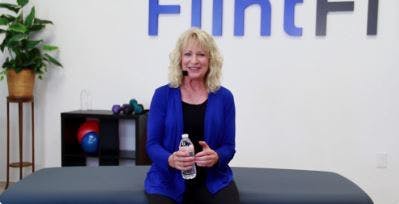
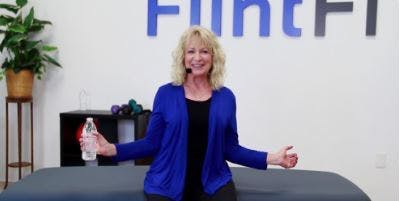
For this last arm recovery exercise, hold a water bottle with your affected hand and keep your elbows close to your sides. Then, open your arms up so that your forearms come out to your sides while keeping your elbows pinned to your side. Return to center and slowly repeat 10 times.
This movement is called external rotation and is necessary for reaching, posture, and counteracting the common internal rotator hypertonicity pattern post-stroke. In other words, with the onset of spasticity and increased muscle tightness, stroke survivors may have their affected arm “curled in” against their chest or out to the side, and this exercise helps counteract that.
See all arm exercises for stroke patients »
Stroke Exercises for Shoulders and Upper Extremity
Shoulder rehab exercises after stroke can help improve and prevent painful conditions like shoulder subluxation and frozen shoulder.
It’s important to practice these exercises with great care because the shoulder is a vulnerable joint susceptible to injury. While some discomfort or muscle soreness is normal, you should never exercise to the point of severe pain. Check with your therapist before attempting these exercises on your own at home.
Weight Bearing Lean
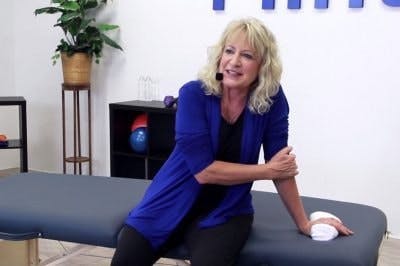
For this passive exercise, start by sitting on the edge of a bed or sofa. Gently prop yourself up on your affected arm about one foot away from your body, using your unaffected hand to stabilize the elbow.
Then gently lean into it. This is called weight bearing; the pressure you place through your arm helps promote joint and bone health, while facilitating more muscle recruitment for stability. You should feel a mild stretch or pressure on your affected side. If it feels good, hold the stretch for 10 seconds, and then return to center. Repeat for a total of 3 sets.
Always remain in a pain-free range for all exercises.
Tabletop Lateral Pushing Exercise
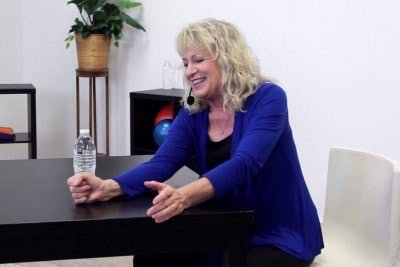
This exercise is more active. Start by placing a water bottle on a table. Then push it laterally across the table using the back of your hand. Once you’ve slid it across, place the front of your hand around the bottle and push it back to the starting position.
Avoid hiking your shoulder during these upper extremity exercises. This is called synergistic movement and it should decrease as your mobility improves.
Tabletop Forward Pushing Exercise
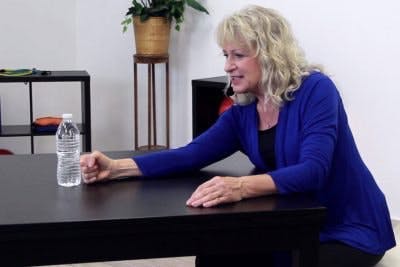
This exercise is similar to the last, but instead of pushing the bottle sideways, you will push it forward away from your body. Once you have completed one repetition, bring the bottle back to the starting position and repeat again. Remember to keep your forearm on the table and avoid elevating your shoulder. Perform a total of 10 repetitions.
See all shoulder exercises for stroke patients »
Stroke Exercises for Wrists, Hands, and Fingers
In our YouTube video above, watch Barbara, OTA, demonstrate a few helpful hand exercises for stroke recovery. You will also find written guidance below.
We provided more exercises for the hand than the other muscle groups because hand function can be “stubborn” and slow to return since it requires fine motor coordination and dexterity. This provides even more reason to practice your stroke exercises with consistency and high repetition.
The first three exercises are passive, making them great for anyone with no movement in their hand. If you have existing movement, these first few exercises can be used as a great warm up.
Hand Surface Stretch
If your fingers are curled or your hand is clenched in a fist, start by stretching your hand and fingers open over your thigh or table. This stroke recovery exercise will help prevent or reduce contractures and stimulate the brain. If possible, try doing this throughout the day for 1 to 2 minutes at a time, instead of just during your stroke recovery exercises.
While you may get a pulling sensation, never stretch to the point of pain.
Wrist Flexion and Extension
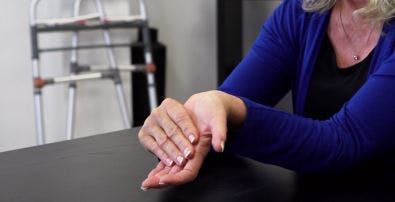
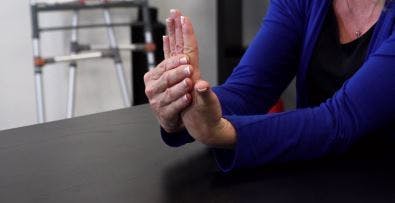
For this hand recovery exercise, rest your elbow on a table with your palm facing upward. Using your non-affected hand, slowly bend the wrist up (flexion) and down (extension). Try to isolate the movement from just the wrist. Repeat slowly for a total of 10 reps.
Wrist Windshield Wipers
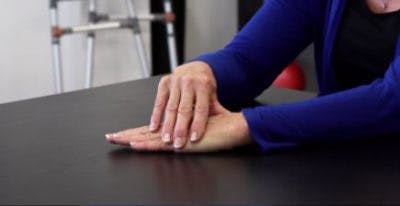
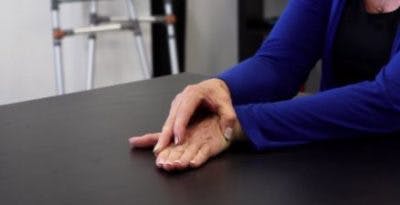
Place your affected hand on the table with your palm down. Use your non-affected hand to slide your hand to the left and then to the right. This windshield wiper movement is called ulnar and radial deviation. Focus on initiating the movement solely from your wrist. Repeat slowly for a total of 10 reps.
Wrist Curl Exercise
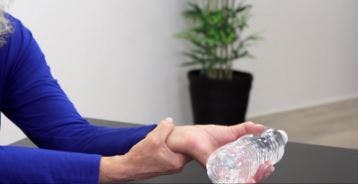
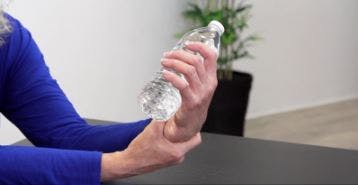
Grasp the water bottle with your affected hand and use your non-affected hand to support your arm and help isolate the wrist movement. Allow your wrist to stretch down, and then curl your wrist up. Repeat 10 times slowly.
The water bottle adds some weight to this recovery exercise. If necessary, you can do it without the bottle or skip it until your strength and mobility improves.
Hand Rolling Movement
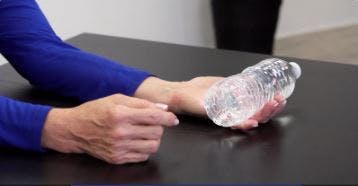
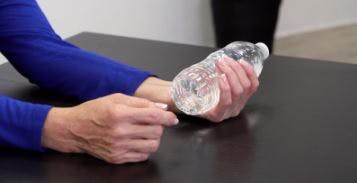
Place a water bottle in your affected hand and then curl your fingers in to grasp and squeeze the water bottle. Hold for 3 seconds, then release your grip. Repeat this stroke recovery exercise a total of 10 times.
Pen Spin (Advanced)
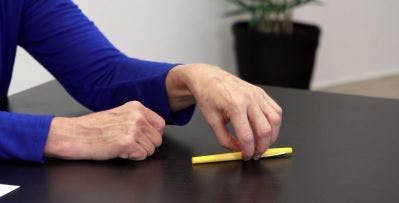
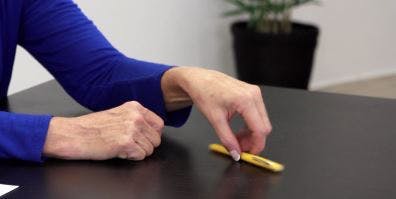
Hand exercises can be difficult for stroke patients due to limited fine motor skills. Over time, your hand spasticity should decrease and, as a result, your mobility should increase.
When you’re ready, try this advanced stroke exercises by spinning a pen with your affected fingers. This can be difficult, so proceed if you are challenged but not frustrated by it.
See all hand exercises for stroke patients »
Stroke Recovery Exercises for Paralysis
To recover from post-stroke paralysis, you need to practice passive exercise. This means assisting your affected limb through the movement, either with the help of a caregiver or by using your non-affected side.
You can create your own paralysis recovery exercises by doing any movement from this guide passively. Below, you’ll find specific stroke exercises that are helpful for paralysis recovery.
Palm Up and Down (Hands)
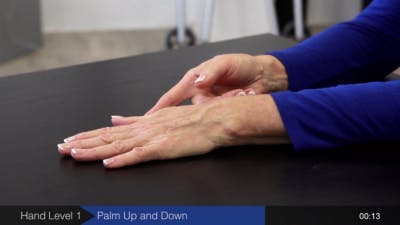
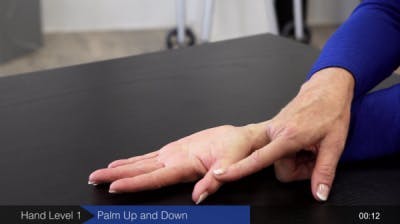
Place your affected hand on a table top with your palm facing up. Then, use your non-affected hand to help flip your palm down. Repeat back and forth to flip your palm up and down a total of 10 times. Again, try to initiate the movement using just your forearm and wrist.
While this exercise may seem simple, it provides stimulation to the brain and encourages neuroplasticity. If your affected hand has no movement, it’s a great way to promote recovery.
Cane Stretch (Arm)
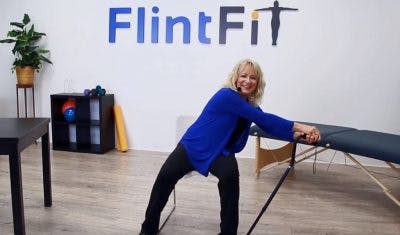
This stroke recovery exercise is great for shoulder mobility but also challenging your balance. Place your affected hand on a cane with your non-affected hand on top. Then, slowly and gently lean onto the cane. You should feel a gentle stretch through your affected arm. Hold for 3 seconds, and then return to center. Repeat 5 times.
This stroke exercise helps provide stimulation to your affected side along with some weight bearing. You can do this during your daily stroke exercise routine and all throughout the day when you are seated with a cane nearby.
Lower Trunk Rotation (Core)
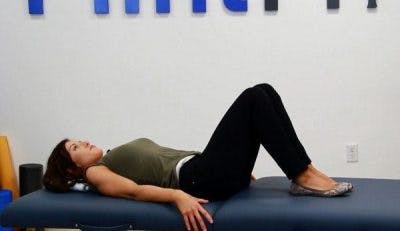
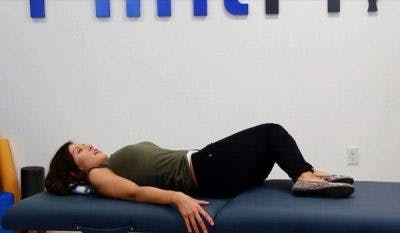
You will need the help of a caregiver for this stroke paralysis exercise.
Start by lying on your back with your knees bent at 90-degrees and feet flat on the floor. Then, let your knees fall to the right and twist your truck to help your legs lower. Then, lift your knees back up and repeat on the other side. Perform for a total of 20 repetitions, trying to initiate the movement with your abdominals. You can use your arms to help stabilize yourself.
See more stroke paralysis exercises »
How Many Repetitions Is Ideal?
Evidence shows that higher doses of therapy lead to better outcomes after stroke. Therefore, between sessions with your therapist, it’s important to exercise on your own at home. But how much?
On average, survivors accomplish about 32 repetitions during a typical therapy session. This low dose of therapy simply isn’t enough, and this is where at-home rehab technology can help.
For instance, Flint Rehab’s FitMi home therapy device transforms 40 classic physical therapy exercises into an engaging game. It helps survivors with limited mobility accomplish an average of 400 repetitions in half an hour.
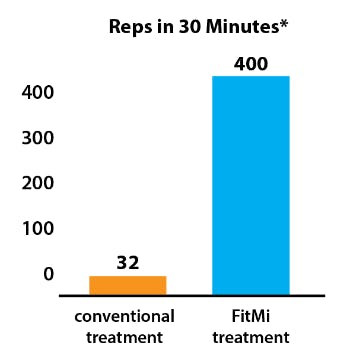
*Based off of averages in a usability study with 22 stroke survivors.
Conventional treatment based off values from this study.
That was just the moderate end, too. Patients with higher ability levels accomplished over 1,600 repetitions in that half hour. Can you imagine how much movement you could recover with that much stimulation on a daily basis?
For an example, check out Ron’s FitMi success story, where he saw movement return to his paralyzed arm within three weeks of using FitMi for passive exercise.
At first he saw twitches in his affected arm, which may not seem like much to a bystander; but any survivor with post-stroke paralysis knows the significance of small, incremental improvements.
Creating Your Stroke Rehab Exercise Program
Whether you use engaging rehab technology like FitMi or follow along to our popular YouTube videos with stroke exercises, try your best to accomplish high repetition on a daily basis.
If you are starting with no movement, you can practice your exercises passively. This helps stimulate the brain and promote recovery. If you already have some movement, you can exercise actively to promote even more functional gains.
For a beautifully illustrated version of this exercise guide, download our free ebook below. It contains all these stroke exercises and more.

